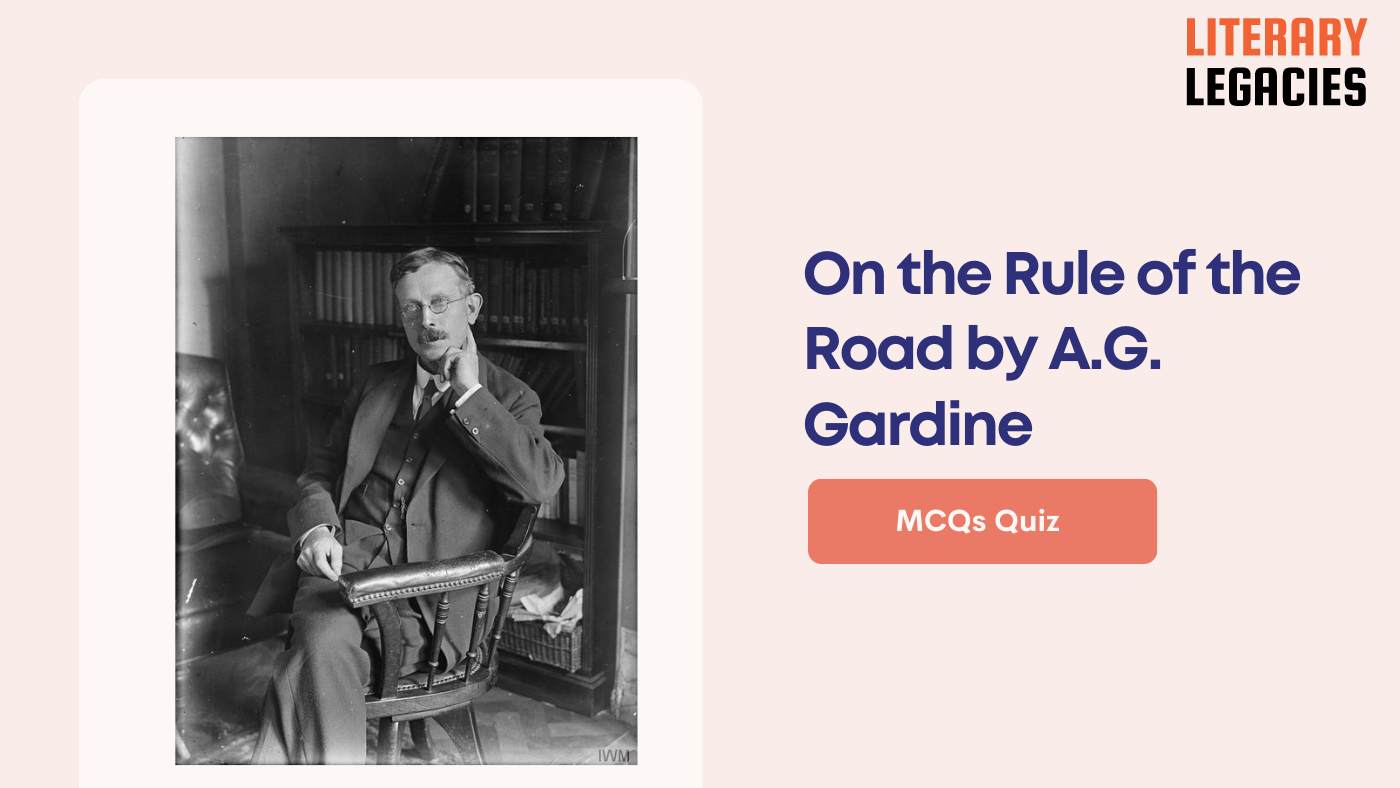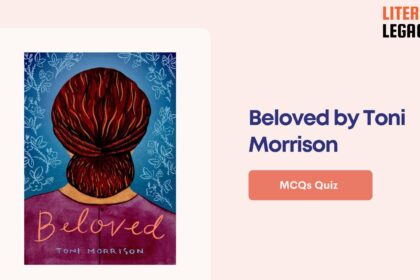1. Under what pseudonym was the essay ‘On the Rule of the Road’ published?
A. Beta of the Plough
B. Gamma of the Plough
C. Omega of the Plough
D. Alpha of the Plough
Answer: Alpha of the Plough (D)
A.G. Gardiner published the essay under the pseudonym ‘Alpha of the Plough’.
2. What is the title of the collection of essays in which ‘On the Rule of the Road’ is included?
A. Leaves of Change
B. Leaves in the Wind
C. Leaves of Liberty
D. Leaves in the Breeze
Answer: Leaves in the Wind (B)
The essay ‘On the Rule of the Road’ is part of the collection ‘Leaves in the Wind’.
3. What was happening in the world when A.G. Gardiner wrote his essays?
A. A war
B. The Renaissance
C. The Industrial Revolution
D. The Enlightenment
Answer: A war (A)
A.G. Gardiner wrote his essays during a time of war.
4. What language are A.G. Gardiner’s essays written in?
A. Russian
B. English
C. French
D. Polish
Answer: English (B)
Although it is mentioned that the essays are written in ‘The Polish’ style, it does not mean the language is Polish. The language is actually English.
5. What is the main concept reflected in ‘On the Rule of the Road’?
A. The importance of traffic rules
B. The role of liberty in social order
C. The benefits of walking
D. The dangers of old age
Answer: The role of liberty in social order (B)
The essay explores the concept of liberty and its role in understanding and developing social order.
6. What is the location of the incident witnessed by the author?
A. London
B. Petrograd (now Saint Petersburg in Russia)
C. Paris
D. Berlin
Answer: Petrograd (now Saint Petersburg in Russia) (B)
The incident involving the old lady took place in Petrograd, which is now known as Saint Petersburg in Russia.
7. What is the old lady’s response to being told to walk on the pavement?
A. I don’t know the rules of the road
B. I’m afraid of being run over
C. I’m too old to walk on the pavement
D. I’m going to walk where I want to walk. We got liberty now.
Answer: I’m going to walk where I want to walk. We got liberty now. (D)
The old lady responds by saying ‘I’m going to walk where I want to walk. We got liberty now.’
8. What does the author imply the old lady is?
A. Liberty-aware
B. Liberty-drunk
C. Liberty-challenged
D. Liberty-conscious
Answer: Liberty-drunk (B)
The author implies that the old lady is ‘liberty-drunk’, forgetting that personal liberty must be balanced with the liberty of others.
9. What is the author’s style of writing described as?
A. Serious and formal
B. Sad and depressing
C. Complex and confusing
D. Humorous and elegant
Answer: Humorous and elegant (D)
A.G. Gardiner’s writings are known for being graceful, humorous, and elegant.
10. What is the author’s greatness according to the text?
A. His ability to write in different languages
B. His ability to write about historical events
C. His ability to present basic truth of real life in an amusing manner
D. His ability to write complex essays
Answer: His ability to present basic truth of real life in an amusing manner (C)
The author’s greatness lies in his ability to present the basic truth of real life in an amusing manner.
11. What is the main idea of the essay ‘On the Rule of the Road’?
A. To show how policemen breach individual liberty
B. To illustrate the chaos in Piccadilly Circus without a policeman
C. To explain the importance of traffic rules in Piccadilly Circus
D. To emphasize the need for balance between individual liberty and social order
Answer: To emphasize the need for balance between individual liberty and social order (D)
The essay argues that individual liberty must be limited to maintain social order and safety.
12. What does the writer imply when he says ‘the policeman is the symbol of liberty’?
A. Policemen are always right
B. Policemen maintain social order and safety
C. Policemen are only concerned with traffic control
D. Policemen are oppressive
Answer: Policemen maintain social order and safety (B)
The writer argues that the policeman’s actions maintain social order and safety, which in turn maintain individual liberty.
13. What is the writer’s view on an individual’s liberty?
A. One should be completely free to do as they please
B. Individual liberty must be limited to maintain social order
C. Individual liberty is not important in society
D. One should always follow their fantasies without considering others
Answer: Individual liberty must be limited to maintain social order (B)
The writer argues that individual liberty must be limited to maintain social order and safety.
14. What does the writer mean by saying ‘the liberty of individuals must be curtailed to maintain the liberty of all’?
A. Social order is more important than individual liberty
B. Individual liberty must be sacrificed for social order
C. Individual liberty is more important than social order
D. Individual liberty must be limited to maintain social order and safety
Answer: Individual liberty must be limited to maintain social order and safety (D)
The writer argues that individual liberty must be limited to maintain social order and safety.
15. What is the writer’s view on an individual’s freedom to make choices?
A. One should not have any freedom to make choices
B. One should only make choices approved by society
C. One should have freedom to make choices as long as it doesn’t disturb others
D. One should have complete freedom to make choices
Answer: One should have freedom to make choices as long as it doesn’t disturb others (C)
The writer argues that one should have freedom to make choices as long as it doesn’t disturb others.
16. What is the writer’s main concern in the essay?
A. The balance between individual liberty and social order
B. The importance of traffic rules
C. The importance of social conduct
D. The role of policemen in society
Answer: The balance between individual liberty and social order (A)
The essay argues that individual liberty must be balanced with social order and safety.
17. What is the writer’s view on the consequences of unchecked individual liberty?
A. It leads to chaos and anarchy
B. It leads to complete freedom for all
C. It leads to social order and safety
D. It leads to a more civilized society
Answer: It leads to chaos and anarchy (A)
The writer argues that unchecked individual liberty leads to chaos and anarchy.
18. What is the significance of the policeman in Piccadilly Circus?
A. He is only concerned with traffic control
B. He is maintaining social order and safety
C. He is breaching individual liberty
D. He is a symbol of oppression
Answer: He is maintaining social order and safety (B)
The writer argues that the policeman’s actions maintain social order and safety.
19. What is the writer’s view on the importance of considering others’ feelings?
A. It is only important for civilized people
B. It is not important at all
C. It is very important for social order and safety
D. It is somewhat important
Answer: It is very important for social order and safety (C)
The writer argues that considering others’ feelings is important for social order and safety.
20. What is the writer’s main conclusion in the essay?
A. The policeman is the symbol of oppression
B. Individual liberty is more important than social order
C. Social order is more important than individual liberty
D. The balance between individual liberty and social order is essential
Answer: The balance between individual liberty and social order is essential (D)
The essay concludes that the balance between individual liberty and social order is essential.
21. What is the core idea of a truly liberal world?
A. Sacrificing individual liberty for personal gain
B. Giving priority to individual desires over the greater good
C. Focusing on the mistakes of others to improve society
D. Considering the impact of one’s actions on others and society
Answer: Considering the impact of one’s actions on others and society (D)
A truly liberal world requires people to be considerate of each other and think about the impact of their actions.
22. What is the relationship between consideration for others and sacrifice of individual desires?
A. They are directly proportional
B. They go hand in hand
C. They are mutually exclusive
D. They are inversely proportional
Answer: They go hand in hand (B)
Consideration for others and sacrifice of one’s own liberty are intertwined.
23. What is the effect of cumulative small changes in individual behavior?
A. They are undetectable
B. They provide freedom for everyone
C. They have a negligible impact on society
D. They lead to immense sacrifices for the general population
Answer: They provide freedom for everyone (B)
Small changes in individual behavior can add up to create a better life for all.
24. What literary device is used in the phrase ‘If I went to the top of Everest’?
A. Hyperbole
B. Alliteration
C. Personification
D. Metaphor
Answer: Hyperbole (A)
The phrase ‘If I went to the top of Everest’ is an example of hyperbole, used for emphasis and comedic effect.
25. What is the significance of ‘little drops of water making the mighty ocean’?
A. It underscores the need for individual liberty
B. It illustrates the futility of small actions
C. It emphasizes the power of individual actions
D. It highlights the importance of grand sacrifices
Answer: It emphasizes the power of individual actions (C)
The phrase ‘little drops of water making the mighty ocean’ illustrates the impact of small, cumulative changes.
26. What is the author’s central concern in the essay?
A. The consequences of unchecked individual liberty
B. The importance of individual freedom
C. The need for greater individual sacrifices
D. The role of consideration in a liberal society
Answer: The role of consideration in a liberal society (D)
The author emphasizes the importance of consideration for others in a liberal society.
27. What is the connection between individual liberty and the greater good?
A. They are mutually exclusive
B. They are complementary
C. They are unrelated
D. They are inversely proportional
Answer: They are complementary (B)
Individual liberty and the greater good are interconnected in a liberal society.
28. What is the author’s primary goal in the essay?
A. To highlight the importance of considering others
B. To illustrate the inequality of society
C. To advocate for complete individual freedom
D. To emphasize the need for grand sacrifices
Answer: To highlight the importance of considering others (A)
The author’s primary goal is to stress the importance of considering others in a liberal society.
29. What is the relationship between liberty and compromise?
A. Liberty is achieved through absolute freedom
B. Liberty requires individual sacrifices and compromise
C. Liberty is incompatible with compromise
D. Liberty requires no compromise
Answer: Liberty requires individual sacrifices and compromise (B)
In a liberal society, liberty requires individual sacrifices and compromises for the greater good.
30. Where was A.G. Gardiner born?
A. Manchester, England
B. Buckingham, England
C. Essex, England
D. London, England
Answer: Essex, England (C)
A.G. Gardiner’s birthplace is mentioned in the passage.
31. What was A.G. Gardiner’s profession before becoming the editor of the Daily News?
A. Teacher
B. Lawyer
C. Author, journalist, and editor
D. Politician
Answer: Author, journalist, and editor (C)
The passage mentions A.G. Gardiner’s profession before becoming the editor of the Daily News.
32. What was the name of the advocacy group that A.G. Gardiner chaired?
A. National Liberal League
B. National Workers’ Union
C. National Anti-Sweating League
D. National Wage Campaign
Answer: National Anti-Sweating League (C)
The passage mentions the name of the advocacy group that A.G. Gardiner chaired.
33. What is the title of one of A.G. Gardiner’s notable works?
A. The Variety of Youth
B. Pebbles on the Beach
C. Pebbles on the Highway
D. The Variety of Old Age
Answer: The Variety of Old Age (D)
The passage mentions the title of one of A.G. Gardiner’s notable works.
34. Where did A.G. Gardiner die?
A. Essex, England
B. Buckingham, England
C. Manchester, England
D. London, England
Answer: Buckingham, England (B)
The passage mentions the place where A.G. Gardiner died.



